| Systematic Screening: Considerations and Commitment to Continued Inquiry We are fielding questions coming from across the United States about systematic screenings designed to detect students with initial signs of internalizing (e.g., extremely shy, anxious, and/or social withdrawn) and externalizing (e.g., noncompliant, aggressive, and/or defiant) behavior patterns. These data are used to plan positive instructional experiences, moving away from previous wait-to-fail approaches. We have provided guidance for selecting, installing, and using screening data within Comprehensive, Integrated, Three-Tiered (Ci3T) models of prevention on the page below and now, respectfully offer these considerations. Our sincere thanks to our trusted partners for engaging in this important inquiry with us for more than 15 years to date. — September 9, 2020 |
Intro to Systematic Screening TRANSCRIPT
Similar to data from academic screening tools, data from universal behavior screening tools can be used in tiered systems of support to (a) detect students for whom Tier 1 efforts may be insufficient, (b) inform teacher-delivered, low intensity supports, and (c) connect students with evidenced-based Tier 2 (for some) and Tier 3 (for a few) strategies, practices, and programs.
Watch more videos about systematic screening, screening logistics, and screening protocols.
Screening Guidance in the COVID-19 Era
The above 3-min excerpt is from a longer presentation — see below to watch more!
- Abridged version (23 min)
- Full length version (48 min)
|
Systematic Screening: An Overview
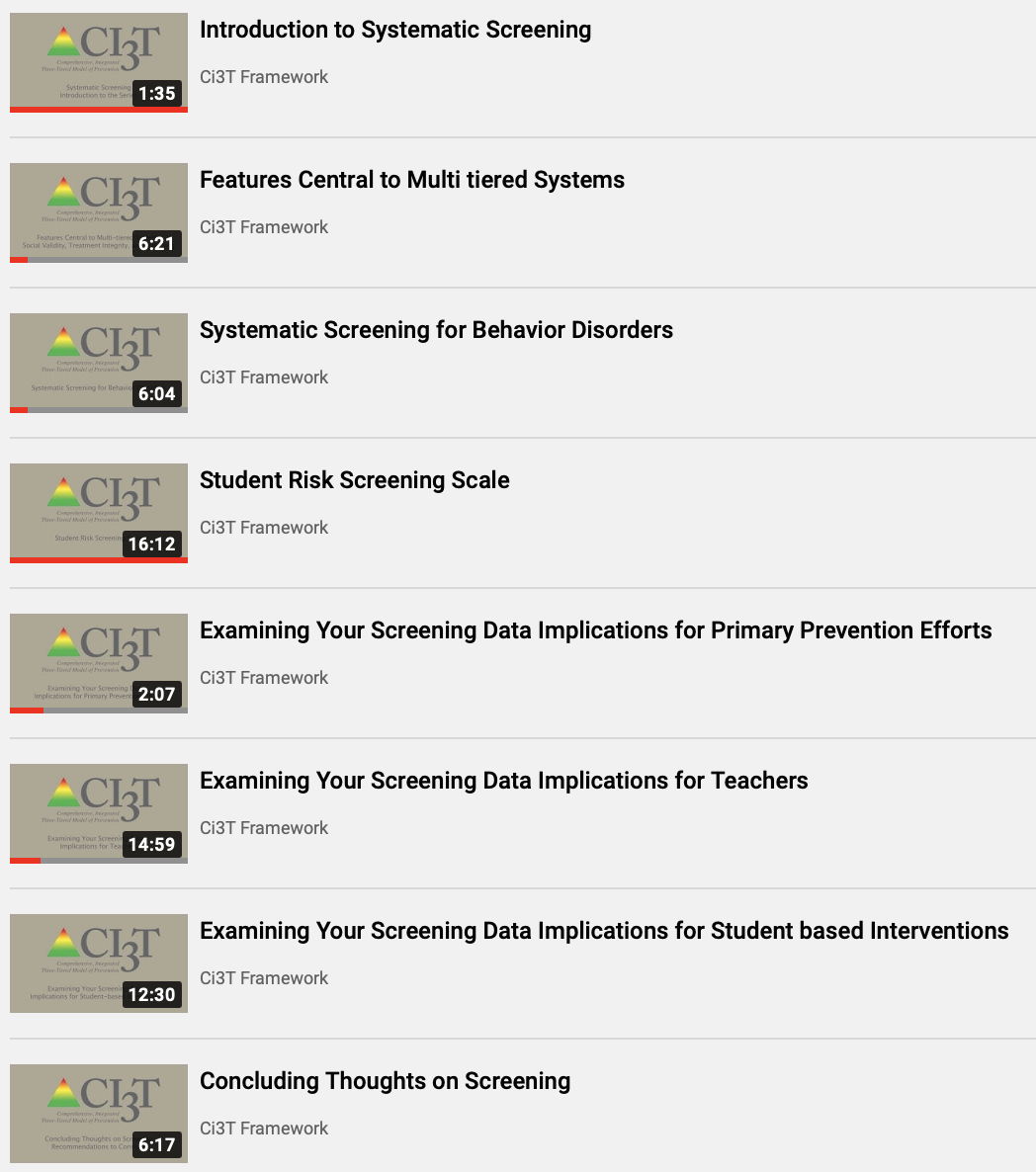 |
Video playlist: Systematic screening |
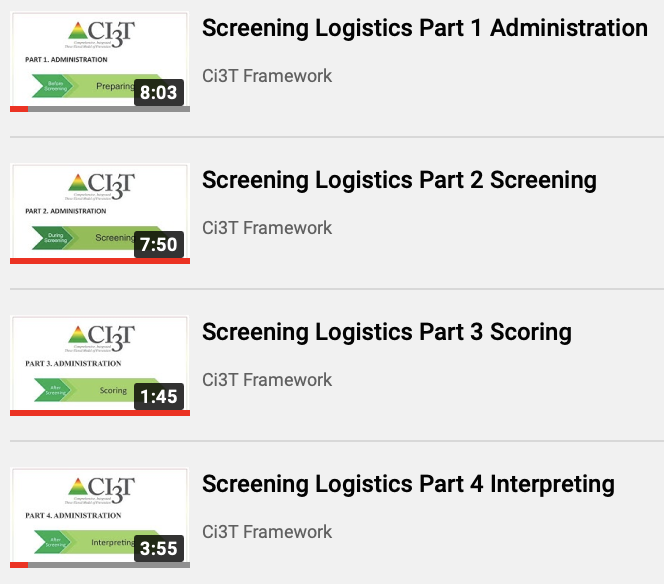 |
Video playlist: Screening logistics |
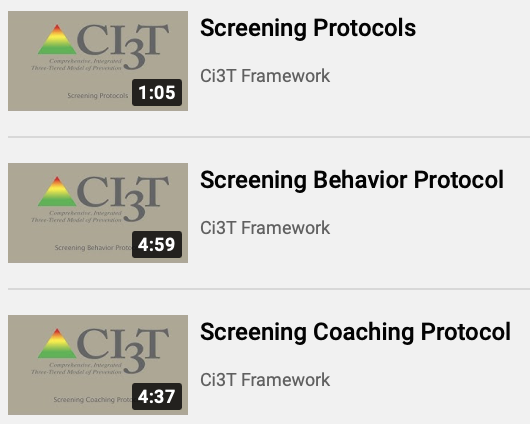 |
Video playlist: Screening protocols |
Screening Tools
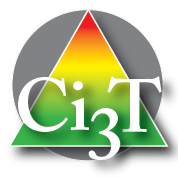 SRSS-IE
SRSS-IE
The Student Risk Screening Scale – Internalizing and Externalizing (SRSS-IE) – is an adapted version of the SRSS (Drummond, 1994) and is available free-access. The SRSS-IE modifies the original 7-item SRSS with the inclusion of 5 new items characteristics of internalizing behaviors. The SRSS-IE includes the original seven items and the new five items with all items rated on the same 4-point Likert-type scale: never = 0, occasionally = 1, sometimes = 2, frequently = 3.
 Cut scores for externalizing and internalizing behaviors are available for elementary and secondary (i.e., middle and high) schools (see table below). See the Enhancing Ci3T Module on the SRSS-IE by clicking on the image to the right. Please also see articles listed below for full details on how cut scores were established at the elementary and secondary levels. Please note the item peer rejection is included in the SRSS-E7 and SRSS-I6 when used at the middle and high school level. The two subscale scores are used for decision making.
Cut scores for externalizing and internalizing behaviors are available for elementary and secondary (i.e., middle and high) schools (see table below). See the Enhancing Ci3T Module on the SRSS-IE by clicking on the image to the right. Please also see articles listed below for full details on how cut scores were established at the elementary and secondary levels. Please note the item peer rejection is included in the SRSS-E7 and SRSS-I6 when used at the middle and high school level. The two subscale scores are used for decision making.
| Elementary School | Middle and High School | |||
| SRSS-E7 | SRSS-I5 | SRSS-E7 | SRSS-I6 | |
| (1) steal; (2) lie, cheat, sneak; (3) behavior problem; (4) peer rejection; (5) low academic achievement; (6) negative attitude; (7) aggressive behavior | (8) emotionally flat; (9) shy, withdrawn; (10) sad, depressed; (11) anxious; (12) lonely | (1) steal; (2) lie, cheat, sneak; (3) behavior problem; (4) peer rejection; (5) low academic achievement; (6) negative attitude; (7) aggressive behavior | (4) peer rejection; (8) emotionally flat; (9) shy, withdrawn; (10) sad, depressed; (11) anxious; (12) lonely |
|
| 0-3 = low risk 4-8 = moderate risk 9-21 = high risk | 0-1 = low risk 2-3 = moderate risk 4-15 = high risk | 0-3 = low risk 4-8 = moderate risk 9-21 = high risk | 0-3 = low risk 4-5 = moderate risk 6-18 = high risk |
|
School level teams use these scores along with other school-collected data (e.g., curriculum-based measures of reading, math, and writing; course failures; office discipline referrals; attendance patterns) to inform instruction and make decisions regarding student needs for more intensive supports (i.e., Tier 2 or Tier 3; see Lane, Oakes, Ennis & Hirsh, 2014).
Download the SRSS-IE (Elementary Version) in MS-Excel format.Download the SRSS-IE (Middle and High School Version) in MS-Excel format.
Note: This file has been updated to include two recommended additional questions related to instructional delivery (in-person, hybrid, and remote) and attendance when screening in the COVID-19 era. These are not items, but two questions to consider when analyzing and interpreting your screening data (see the last two columns).
SRSS-IE Installation Resources
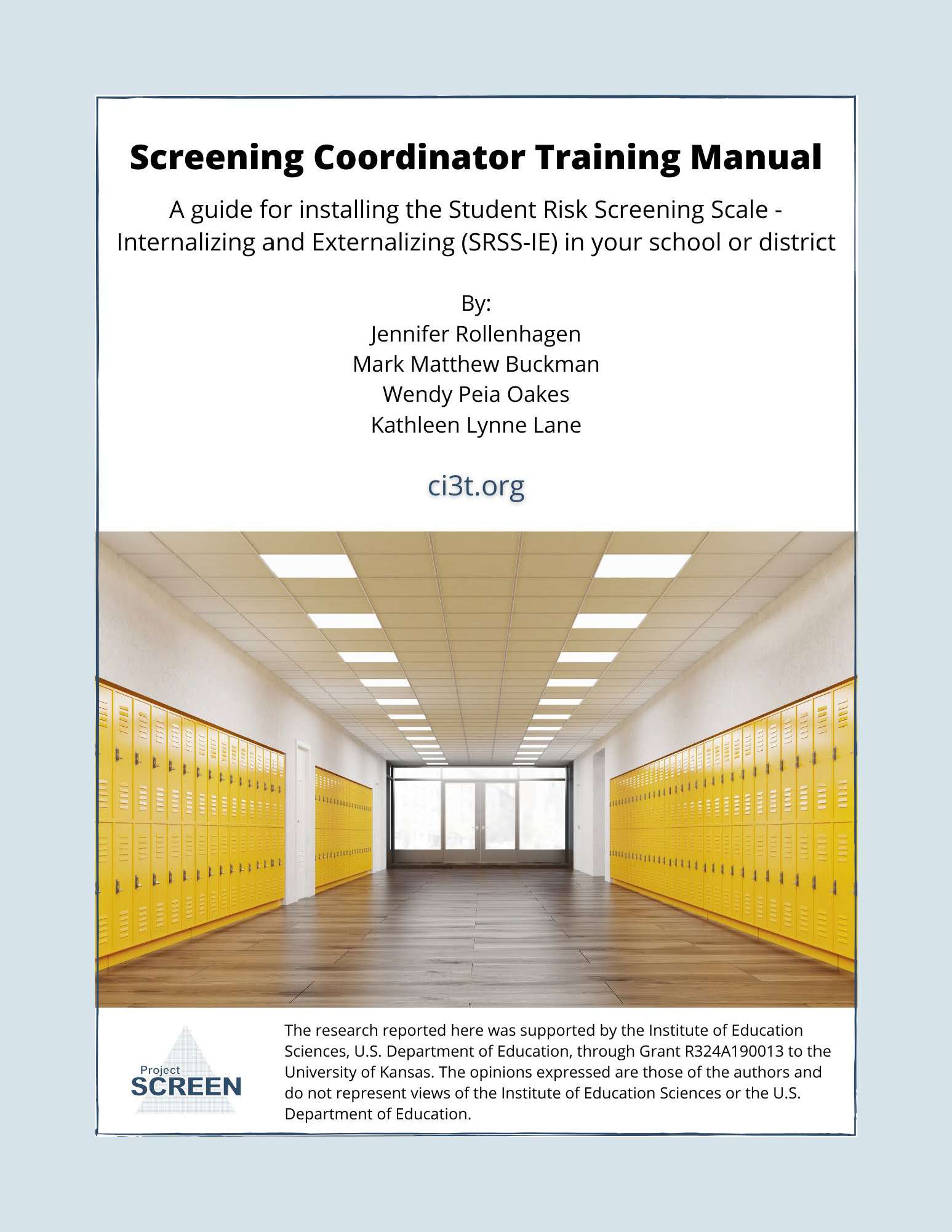 For more information about launching and conducting systematic screening efforts with the SRSS-IE, we invite you to access the Screening Coordinator Training Manual: A Guide for Installing the SRSS-IE in your School or District (available as downloadable PDF or browser-based eBook), as well as two accompanying screening protocols:
For more information about launching and conducting systematic screening efforts with the SRSS-IE, we invite you to access the Screening Coordinator Training Manual: A Guide for Installing the SRSS-IE in your School or District (available as downloadable PDF or browser-based eBook), as well as two accompanying screening protocols:
- Systematic Screening: Setting up to Screen in Your District or School
- Systematic Screening: Site-Level Preparation Protocol
After screening, Ci3T Leadership Teams may wish to create screening reports to facilitate use of data and for sharing information with stakeholders in aggregate format. The below PowerPoint template provides a customizable structure to assist in reporting these data:
We also encourage you to read the following articles to learn more about how to use the SRSS-IE at elementary as well as middle and high schools.
Elementary School Level:
Lane, K. L., Oakes, W. P., Swogger, E. D., Schatschneider, C., Menzies, H., M., & Sanchez, J. (2015). Student risk screening scale for internalizing and externalizing behaviors: Preliminary cut scores to support data-informed decision making. Behavioral Disorders, 40(3), 159-170. https://doi.org/10.17988/0198-7429-40.3.159
Middle and High School Levels:
Lane, L. K., Oakes, W. P., Cantwell, E. D., Schatschneider, C., Menzies, H., Crittenden, M., & Messenger, M. (2016). Student Risk Screening Scale for internalizing and externalizing behaviors: Preliminary cut scores to support data-informed decision making in middle and high schools. Behavioral Disorders, 42(1), 271-284. https://doi.org/10.17988/bd-16-115.1
 SRSS-EC
SRSS-EC
The Student Risk Screening Scale - Early Childhood (SRSS-EC) is a free-access screening tool modeled after the Student Risk Screening Scale (SRSS; Drummond, 1994) and the Student Risk Screening Scale – Internalizing and Externalizing (SRSS-IE; Drummond, 1994; Lane & Menzies, 2008). The SRSS-EC has 11 items split across two subscales representing characteristics of externalizing (SRSS-EC E7) and internalizing (SRSS-EC I4) behaviors of young children. To complete the SRSS-EC, educators independently rate each student on each item using the following 4-point Likert-type scale: never = 0, occasionally = 1, sometimes = 2, frequently = 3.
Preliminary cut scores for externalizing and internalizing behaviors are now available (see table below). We have conducted four studies to date, published in Lane et al. (2015) and Lane et al. (in 2020). The latter study reports findings used to develop the current cut scores. Click here to download a research brief of current findings on the SRSS-EC. We will continue to post new lessons as they are learned.
| SRSS-EC E7 (Externalizing) | SRSS-EC I4 (Internalizing) |
| • Tantrums • Active, restless • Rejected by peers • Ignores teacher and class rules • Negative attitude • Aggressive behavior • Lies | • Shy, timid • Sad, tearful • Worried, fearful • Physical complaints |
| 0-5 = low risk 6-7 = moderate risk 8-21 = high risk | 0-2 = low risk 3-4 = moderate risk 5-12 = high risk |
Download the updated SRSS-EC in MS-Excel format.
Download the SRSS-EC Coaching Protocol, which provides instructions on how to set up and conduct systematic screenings in your early childhood center.
Download the updated SRSS-EC in MS-Excel format.
Download the SRSS-EC Screening Report Template, which provides a customizable template for using and sharing these data in an aggregate format.
Studies of the SRSS-EC:
Lane, K. L., Buckman, M. M., Common, E. A., Oakes, W. P., Lane, N. A., Schatschneider, C., Perez-Clark, P., Sherod, R. L., & Menzies, H. M., (2020). The Student Risk Screening Scale for Early Childhood: Additional validation studies. Topics in Early Child Special Education. https://doi.org/10.1177/0271121420922299
Lane, K. L., Oakes, W. P., Menzies, H. M., Major, R., Allegra, L., Powers, L., & Schatschneider, C. (2015). The Student Risk Screening Scale for Early Childhood: An initial validation study. Topics in Early Childhood Special Education 34(4), 234-259. https://doi.org/10.1177/0271121414544801
 Student Risk Screening Scale (SRSS)
Student Risk Screening Scale (SRSS)
SRSS Video TRANSCRIPT
The STUDENT RISK SCREENING SCALE (SRSS) is a free-access tool, originally developed to detect elementary students at risk of anti-social behavior patterns (Drummond, 1994). Students are individually rated on seven items using a 4-point Likert-type scale: never = 0, occasionally = 1, sometimes = 2, frequently = 3. These items are: (1) steal; (2) lie, cheat, sneak; (3) behavior problem; (4) peer rejection; (5) low academic achievement; (6) negative attitude; and (7) aggressive behavior. Once the items are summed for each student, the student’s total score falls into one of three categories of risk: low (0-3), moderate (4-8), or high (9-21). Supports (secondary, tertiary) are considered for students based on the category of their individual score. Students in the moderate or high risk categories should be considered by educators for additional supports and interventions at the school-site. Additionally, aggregated SRSS data can be utilized to monitor the level of risk over time within grade levels, school buildings, or a district (Lane, Kalberg, Bruhn, Mahoney, & Driscoll, 2008). Since its initial development, the SRSS has been validated for use at the elementary (e.g., Drummond, Eddy, & Reid, 1998), middle (Lane, Parks, Kalberg, & Carter, 2007) and high (Lane, Kalberg, Parks, & Carter, 2008; Lane, Oakes, Ennis, Cox, Schatschneider, & Lambert, 2013) school levels. Furthermore, this screening tool has been found to be socially valid (e.g., Lane, Bruhn, Eisner, & Kalberg, 2010) and psychometrically sound (Lane, Little, et al., 2009). Specifically, Lane, Little, et al., (2009) found the SRSS total scores improved chance estimates by 45% for detecting students with externalizing (e.g., aggressive, noncompliant) behavior patterns and 30% for detecting students with internalizing (e.g., anxious, socially withdrawn) behavior patterns. The SRSS has been used widely in studies to (a) determine the responsiveness of students within the context of multi-tiered models of prevention, (b) illustrate how a school’s risk shifts over time, and (c) to identify students in need of secondary (Tier 2) or tertiary (Tier 3) supports.
For more information, examples, and a voiced-over PowerPoint presentation by Kathleen Lane, visit Michigan's integrated behavior and learning support initiative site.
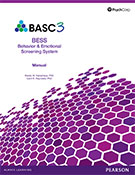 Behavior Assessment System for Children 3rd Edition: Behavioral and Emotional Screening System (BASC-3: BESS)
Behavior Assessment System for Children 3rd Edition: Behavioral and Emotional Screening System (BASC-3: BESS)
The BEHAVIOR ASSESSMENT SYSTEM FOR CHILDREN 2ND EDITION: BEHAVIORAL & EMOTIONAL SCREENING SYSTEM (BASC-3: BESS; Kamphaus & Reynolds, 2007) is a brief, universal screening system for measuring behavioral and emotional strengths and weaknesses in children and adolescents preK-12 in a reliable, quick, systematic way. Forms can be scored by hand or completed as part of AIMSweb assessment and data management system. The BASC-2: BESS was designed to identify kids with behavioral or emotional patterns that impact academic achievement or social relationships. Keeping in mind that students behave differently for different people and in different settings or contexts, the BASC-3: BESS relies on multiple informants (teacher, parent, student) to obtain a comprehensive understanding of student strengths and weaknesses. Behavioral areas assessed include (a) Internalizing problems, (b) Externalizing problems, (c) School problems, and (d) Adaptive skills. The BASC-3: BESS includes three forms that can be used individually or in combination (Spanish-language versions available for parent and student forms): (a) Teacher: Preschool and Child/Adolescent, (b) Student self-report: Child/Adolescent, and (c) Parent: Preschool and Child/Adolescent.
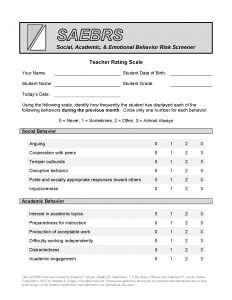 Social, Academic, & Emotional Behavior Risk Screener (SAEBRS)
Social, Academic, & Emotional Behavior Risk Screener (SAEBRS)
The SOCIAL, ACADEMIC, & EMOTIONAL BEHAVIOR RISK SCREENER (SAEBRS; Kilgus, Chafouleas, Riley-Tillman, & von der Embse, 2013) is a brief (1-3 minutes per student) universal screening tool for behavioral and emotional risk designed for use across the K-12 grade span. The measure consists of 19 items divided between 3 scales: social behavior (6 items), academic behavior (6 items), emotional behavior (7 items). Research suggests the SAEBRS may be used to evaluate overall general behavior, as assessed by the total of the items Total Behavior (19 items). Raters identify how frequently the student has displayed behaviors during the previous month using the following 4-point Likert-type scale: 0 = Never, 1 = Sometimes, 2 = Often, 3 = Almost Always. Prior to scoring, negatively worded items are reversed scored.
For more information, please consider reading the SAEBRS brief or review the provided PowerPoint Show.
 - Strengths and Difficulties Questionnaire (SDQ)
- Strengths and Difficulties Questionnaire (SDQ)
The STRENGTHS AND DIFFICULTIES QUESTIONNAIRE (SDQ; Goodman, 1997) is a validated and widely used free-access systematic screening tool with elementary and secondary versions for use with students ages 2 to 17 (as of June 2014; based on the performance of the SDQ with 17-year-olds being similar to that in 15- and 16-year-olds and good psychometric properties in 2-year-olds; see SDQinfo.com for more information). Appropriate use of screening tools such as the SDQ allow schools to determine how students are progressing over time and to collect reliable data to draw accurate conclusions about how different types of students (e.g., students receiving general education, students receiving special education) are responding (Lane, Wehby, Robertson, & Rogers, 2007). The 25-item SDQ screening tool is available in many languages and assesses a broad set of behavioral domains and comes in an early years version (ages 2-4) and a standard version for elementary (ages 4-10) or secondary (ages 11-17). One page is completed on each student, asking for about 25 positive (e.g., “Considerate of other people’s feelings”) and negative (e.g., “Fears or easily scared”) attributes rated on a 3-point Likert-type scale where 0 = not true, 1 = somewhat true, and 2 = certainly true to determine occurrence of each behavior during the last six months or the current school year. The 25 attributes divide between five scales:
1. Emotional Symptoms
2. Conduct Problems
3. Hyperactivity / Inattention
4. Peer Relationship Problems
5. Prosocial Behavior and Total Difficulties (sum of first four scales)
The SDQ considers input from multiple stakeholders, seeking teacher, parent, and student perspectives to assess a given individual’s behavioral performance (Lane, Menzies, Oakes, & Kalberg, 2012).
 Systematic Screening for Behavior Disorders (SSBD, 2nd Edition)
Systematic Screening for Behavior Disorders (SSBD, 2nd Edition)
The SYSTEMATIC SCREENING FOR BEHAVIOR DISORDERS (SSBD; Walker, Severson, & Feil, 2014) 2nd edition is validated for grades PK-9 and a widely used multi-gated universal screening tool designed to find students who have either internalizing or externalizing patterns of behavior. Many consider the SSBD to be the “gold standard” in screening. This teacher completed tool has three stages: (1) nomination and rank ordering, (2) behavior scales, and (3 optional for universal screening purposes) the School Archival Records Search (SARS) and direct observations of student behavior (classroom and playground). With the updated 2014 2nd edition, screening with the SSBD is available online or in a paper format. Screening a class of students takes less than one hour to complete. In stage one, the classroom teacher considers all students’ behavior patterns using the descriptions of internalizing and externalizing behavior dimensions, selecting the three students with behaviors most like the each description. These six students (three for externalizing and three for internalizing) pass through Gate 1 on to stage two. In stage two, the six students are then rated by the teacher on behavior scales: Critical Events Index and Combined Frequency Index of Adaptive and Maladaptive Behavior. Students who exceed normative criteria on these two indices pass through Gate 2 on to stage three. In stage 3, a trained professional directly observes students in an instructional settings (academic engaged time) and on the playground (positive social behavior). The preschool scales (Early Screening Project, ESP) vary slightly in terms of behavior scales and observation setting.
 Social Skills Improvement System - Performance Screening Guide (SSIS-PSG)
Social Skills Improvement System - Performance Screening Guide (SSIS-PSG)
The SOCIAL SKILLS IMPROVEMENT SYSTEM - PERFORMANCE SCREENING GUIDE (SSiS-PSG; Elliott & Gresham, 2008) is an efficient screening tool for Preschool-Secondary. The SSiS–PSG is one tool in a family of products for screening, assessment, instruction, and intervention. The SSiS-PSG screens four skill domains: Prosocial Behavior, Motivation to Learn, Reading Skills, and Math Skills. Educators rate each student’s skills using a 5-level descriptive criterion. Educators are able to quickly assess results corresponding to the color band for each domain – green band indicating the student is at or above expected levels of functioning for their age, yellow band indicating moderate concern, and red band indicating a high level of concern. Then educators list, on the last page of the screening tool, the students in each of the yellow and red risk band and determine appropriate interventions with the support of their school teams.
SCREENING PROTOCOLS
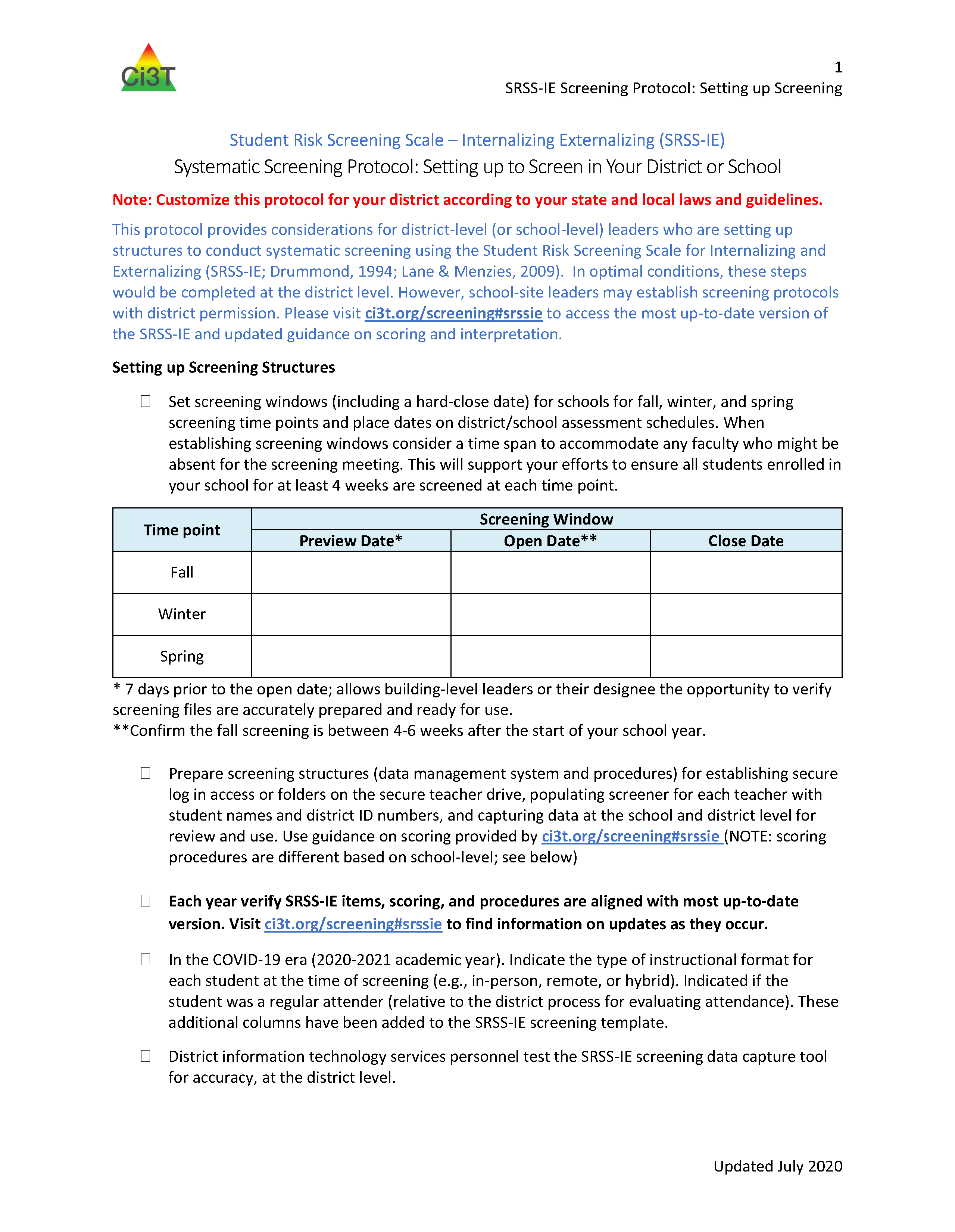 | STUDENT RISK SCREENING SCALE - INTERNALIZING AND EXTERNALIZING (SRSS-IE) SETTING UP TO SCREEN IN YOUR DISTRICT OR SCHOOL • Download MS-Word format (24 KB) • Download PDF format (503 KB) |
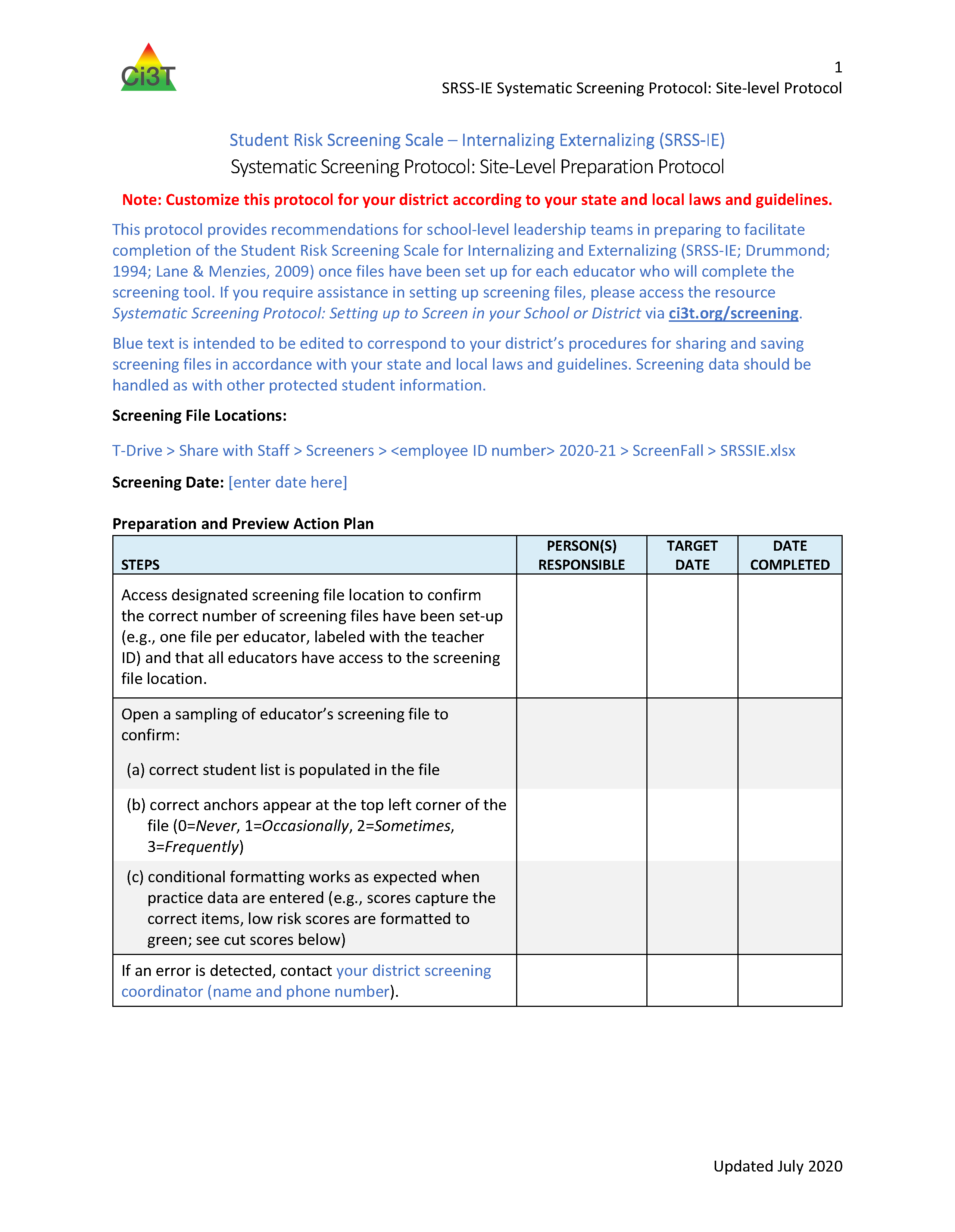 | STUDENT RISK SCREENING SCALE - INTERNALIZING AND EXTERNALIZING (SRSS-IE) SITE-LEVEL COACHING PROTOCOL • Download MS-Word format (23 KB) • Download PDF format (301 KB) |
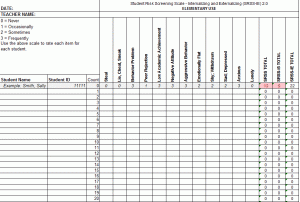 | STUDENT RISK SCREENING SCALE - INTERNALIZING AND EXTERNALIZING (SRSS-IE) • Download MS-Excel format (53 KB) Note (08/05/2020): This file has been updated to include two recommended additional questions related to instructional delivery (in-person, hybrid, and remote) and attendance when screening in the COVID-19 era. These are not items, but two questions to consider when analyzing and interpreting your screening data (see the last two columns). This file contains 3 tabs, one for elementary schools, one for middle/high schools, and one containing important notes. • The SRSS-IE retains the original 7 items of the SRSS (Drummond, 1994). For more information on the SRSS, examples, and a voiced-over PowerPoint presentation by Kathleen Lane, please visit Michigan's integrated behavior and learning support initiative site. • Please exercise caution when using the preliminary cutting scores for internalizing behaviors. Please review currently available information to guide your implementation decisions. For more information on the new secondary level (middle and high school) preliminary cut scores, please consider reading the SRSS-IE MS HS Brief. |
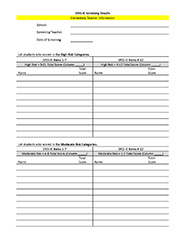 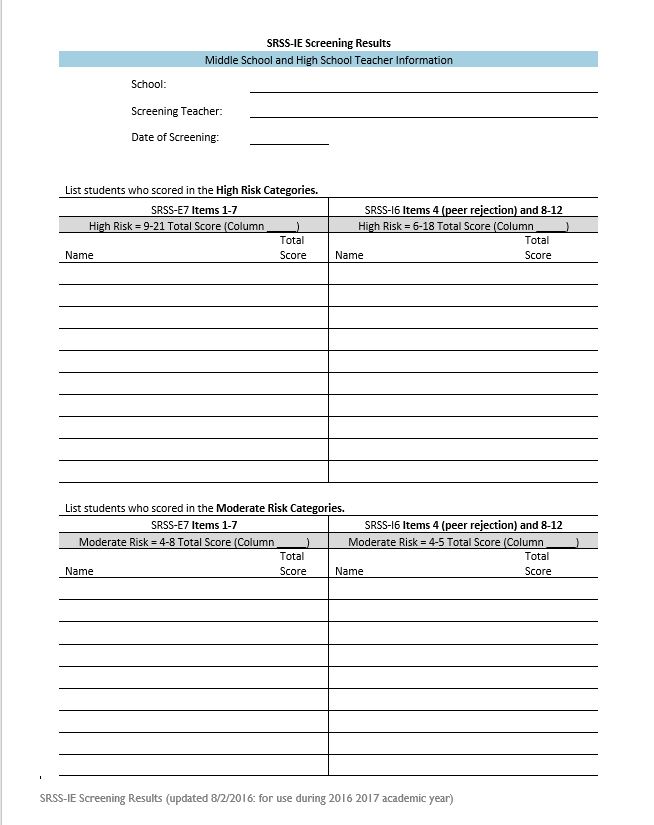 | STUDENT RISK SCREENING SCALE - INTERNALIZING AND EXTERNALIZING (SRSS-IE) RESULTS: ELEMENTARY VERSION Educators may use this sheet to record student names and SRSS-IE scores in the moderate and high-risk categories. Note: the moderate and high-risk category score ranges in this document for the internalizing subscale (Items 8-12) are only applicable to ELEMENTARY students. • Download MS-Word format (22KB) • Download PDF format (294 KB) STUDENT RISK SCREENING SCALE - INTERNALIZING AND EXTERNALIZING (SRSS-IE) RESULTS: MIDDLE AND HIGH SCHOOL VERSION Educators may use this sheet to record student names and SRSS-IE scores in the moderate and high-risk categories. Note: the moderate and high-risk category score ranges in this document for the internalizing subscale (Items 8-12) are only applicable to MIDDLE AND HIGH SCHOOL students. • Download MS-Word format (25 KB) • Download PDF format (254 KB) |
Michigan SRSS-IE Training Resources
The MiMTSS Technical Assistance Center, previously Michigan’s Integrated Behavior and Learning Support Initiative (MIBLSI), worked with the SRSS-IE authors and researchers from 2012 to 2020 to develop companion resources to the SRSS-IE for Michigan schools. These materials, developed prior to March 2020, are posted here to support schools using the SRSS-IE until additional research and resources developed by the test authors are available to replace these materials.
SRSS-IE Coordinator Resources
- SRSS-IE Roles Collection and Analysis Decisions
- SRSS-IE Data Accuracy Checklist
- SRSS-IE Coordinator Script for Training Staff
- SRSS-IE Staff Overview Slide Deck
- SRSS-IE Coordinator Job Description
- SRSS-IE Coordinator Roles and Responsibilities
- SRSS-IE Coordinator Professional Learning Plan
SRSS-IE Coordinator Training Resources
- SRSS-IE Coordinator Presentation
- SRSS-IE Background Knowledge Activity
- Student Assessment Communication Example
- Sample Data for Practicing Data Entry
- Practice with CICO Decision Rules using SRSS-IE
References
Bruhn, A. L. (2011). Measuring primary plan treatment integrity of comprehensive, integrated three-tiered prevention models. (Unpublished doctoral dissertation). Vanderbilt University,
Nashville, TN.Elliott, S. N., & Gresham, F. M. (2008). Social Skills Improvement System (SSiS): Performance Screening Guides. San Antonio, TX: PsychCorp Pearson Education.Feil, E. G.,
Walker, H. M., & Severson, H. H. (1995). The Early Screening Project for young children with behavior problems: Research and development of the early screening project. Journal of Emotional and Behavioral Disorders, 3(4), 194-202.
Lane, K. L. (2002). Primary Prevention Plan: Feedback Form. Unpublished rating scale.Lane, K. L. (2009a). Teacher self-report form. Unpublished instrument.
Lane, K. L. (2009b). CI3T treatment integrity: Direct observation tool. Unpublished instrument.
Lane, K. L., Kalberg, J. R., Bruhn, A. L., Driscoll, S. A., Wehby, J. H., & Elliott, S. (2009). Assessing social validity of school-wide positive behavior support plans: Evidence for the reliability and structure of the Primary Intervention Rating Scale. School Psychology Review, 38, 135-144.
Lane, K. L., Kalberg, J. R., Bruhn, A. L., Mahoney, M. E., & Driscoll, S. A. (2008). Primary Prevention Programs at the Elementary Level: Issues of Treatment Integrity, Systematic Screening, and Reinforcement. Journal of Education and Treatment of Children. 31, 466-494.
Lane, K. L., Little, M. A., Casey, A. M., Lambert, W., Wehby, J., Weisenbach, J. L., & Phillips, A. (2009). A comparison of systematic screening tools for emotional and behavioral disorders. Journal of Emotional and Behavioral Disorders, 17(2), 93-105. DOI: 10.1177/1063426608326203.
Lane, K. L., Oakes, W. P., Common, E. A., Zorigian, K., Brunsting, N. C., & Schatschneider, C. (2014). A comparison between SRSS-IE and SSiS-PSG scores: Examining convergent validity. Assessment for Effective Intervention, 1-13. doi: 10.1177/1534508414560346.
Lane, K. L., Oakes, W. P., Ennis, R. P., & Hirsch, S. E. (2014). Identifying students for secondary and tertiary prevention efforts: How do we determine which students have Tier 2 and Tier 3 needs?Preventing School Failure, 58, 171-182.
Lane, K. L., Oakes, W. P., Harris, P. J., Menzies, H. M., Cox, M., & Lambert, W. (2012). Initial evidence for the reliability and validity of the student risk screening scale for internalizing and externalizing behaviors at the elementary level. Behavioral Disorders, 99-122.
Lane, K. L., Oakes, W. P., Jenkins, A., Menzies, H. M., & Kalberg, J. R. (2014). A team-based process for designing comprehensive, integrated, three-tiered (CI3T) models of prevention: How does my school-site leadership team design a CI3T model? Preventing School Failure: Alternative Education for Children and Youth, 58 (3), 129-142. DOI: 10.1080/1045988X.2014.893976
Lane, K. L., Oakes, W. P., & Magill, L. (2014). Primary prevention efforts: How do we implement and monitor the tier 1 component of our comprehensive, integrated, three-tiered (ci3t) model?Preventing School Failure: Alternative Education for Children and Youth, 58(3), 143-158. doi: 10.1080/1045988X.2014.893978
Lane, K. L., Oakes, W. P., Swogger, E. D., Schatschneider, C., Menzies, H., M., & Sanchez, J. (2014). Student risk screening scale for internalizing and externalizing behaviors: Preliminary cut scores to support data-informed decision making. Behavioral Disorders.
Lane, K. L., Robertson, E. J., & Wehby, J. H. (2002). Primary Intervention Rating Scale. Unpublished rating scale.
Lynass, L., Tsai, S., Richmond, T., & Cheney, D. (2012). Social expectations and behavioral indicators in schoolwide positive behavior supports: A national study of behavior matrices. Journal of Positive Behavior Interventions, 14, 153-161.
Oakes, W.P., Lane, K.L., Jenkins, A., & Booker, B.B. (2013). Three-tiered models of prevention: Teacher efficacy and burnout. Education and Treatment of Children, 36(4), 95-126.
Walker, H. M., Severson, H. H., & Feil, E. G. (2014). Systematic screening for behavior disorders (SSBD) technical manual: Universal screening for preK–9 (2nd ed.). Eugene, OR: Pacific Northwest Publishing.
Watch more videos about systematic screening, screening logistics, and screening protocols.
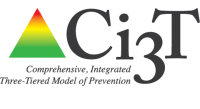
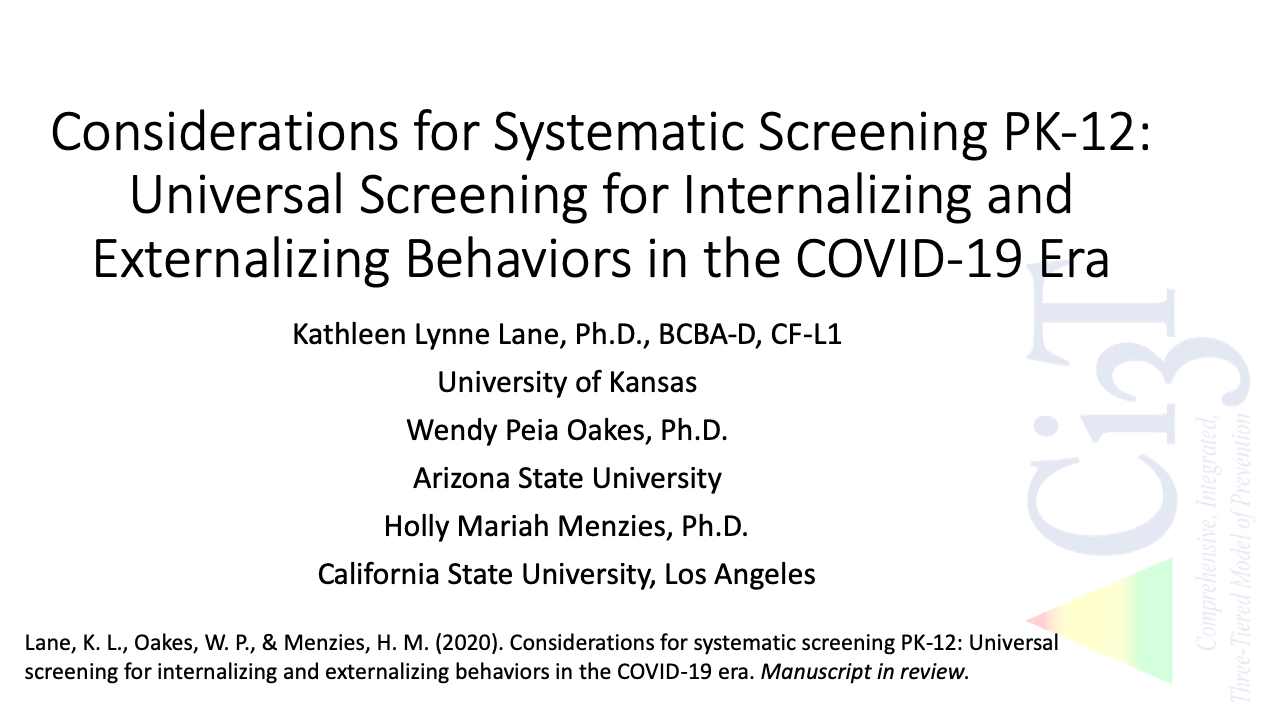 Considerations for Systematic Screening PK-12: Universal Screening for Internalizing and Externalizing Behaviors in the COVID-19 Era
Considerations for Systematic Screening PK-12: Universal Screening for Internalizing and Externalizing Behaviors in the COVID-19 Era